Creativity and Systems Thinking: The New Leadership Superpower
In a world that rewards speed, agility and innovation, the leaders who thrive aren’t just reacting to change, they’re anticipating it, shaping it and solving complex problems before they explode. How? By combining two often overlooked leadership capabilities: creativity and systems thinking.
At FutureX Leaders, we believe the most future-ready leaders are those who can see the system and shift it, while also imagining entirely new ways forward. Creativity and systems thinking aren’t separate skills, they’re two sides of the same leadership coin. Together, they help leaders move from reactive firefighting to visionary problem-solving.
Systems Thinking: See the Whole, Not Just the Parts
Most leadership challenges aren’t linear, they’re messy, dynamic and interconnected. Enter systems thinking: a mindset and method for understanding the bigger picture.
Systems thinkers see:
Interconnectedness: How one action ripples through an organisation.
Feedback loops: How today’s solutions might become tomorrow’s problems.
Leverage points: Where small changes can create massive impact.
Imagine a team struggling with burnout. A surface-level fix might be to give time off. A systems thinker would explore the deeper loops: unclear priorities, lack of autonomy, or communication bottlenecks.
Leadership impact multiplies when you stop solving symptoms and start shifting systems.
To practice systems thinking:
Use the Systems Mapping Template to identify patterns.
Ask: What are the hidden forces at play here? What’s influencing what?
Zoom out. Connect dots others don’t see.
Creative Thinking: Design Bold Solutions, Not Just Safe Bets
Creativity isn’t about artistic talent, it’s about original thinking in service of better outcomes. FutureX Leaders are creators, not just problem-solvers. They don’t just ask “What’s broken?” they ask, “What’s possible?”
Creative leaders:
Use tools like mind mapping and design thinking to generate bold ideas.
Reframe problems to uncover hidden opportunities.
Create space for experimentation, knowing failure is part of the process.
Try this now:
Write down your current leadership challenge.
Flip it. Instead of asking, “How do I fix this?” ask, “What’s another way to look at this?”
Use the Creative Problem-Solving Worksheet to generate 5 wild ideas, then refine.
Creativity is the fuel. Systems thinking is the map. Together, they help leaders design better futures.
Grow a Mindset for Innovation
You can’t lead creatively with a fixed mindset. FutureX leaders are learners, not perfectionists. They experiment, reflect and grow.
Ask yourself:
When was the last time I took a smart risk?
How do I respond to failure, personally and with my team?
Do I create psychological safety for experimentation, or subtly punish it?
To grow your innovation mindset:
Celebrate effort and insight, not just outcomes.
Build weekly reflection rituals: What did we try? What did we learn?
Use failure as data, not drama.
Innovation requires trust, space, and courage. Make it part of your culture, not just your strategy.
Use Systems Thinking in Strategic Planning
Too many strategic plans sit in folders, disconnected from reality. Future-ready leaders use systems thinking to make strategy dynamic, adaptive, and alive.
Here’s how:
Map out stakeholders, forces, and feedback loops.
Use scenario planning to imagine multiple futures.
Identify leverage points where focused action creates ripple effects.
Try this framework:
Map the system – who/what is involved?
Spot feedback loops – what’s reinforcing or sabotaging progress?
Choose a leverage point – where’s the best place to intervene?
Prototype & learn – test small, adapt fast.
Strategic thinking becomes truly powerful when it’s grounded in systems awareness and designed with creativity.
Apply It to Teams: Create, Connect, Collaborate
Creativity and systems thinking aren’t solo acts they thrive in collaborative spaces. When teams adopt this mindset, silos break, energy rises, and real innovation happens.
Encourage your team to:
Run creative problem-solving sprints.
Co-create a system map of your biggest team challenge.
Reflect on how team dynamics affect innovation, where’s the friction, where’s the flow?
Consider this prompt: What part of our team rhythm is helping us innovate and what’s silently killing it?
Real creativity happens when diverse minds align around a shared challenge with trust, time and tools.
Lead the Future: Scenario Planning Starts Now
FutureX leaders don’t just plan for one outcome. They plan for several. Scenario planning helps you anticipate different futures and build agility. Using the Scenario Planning Worksheet, sketch out:
A likely future
A disruptive future
A hopeful stretch future
Then ask:
What strategies work across all three?
What signals would tell me one scenario is unfolding?
How can I prepare my team without creating fear?
Scenario thinking isn’t about predicting. It’s about preparing with clarity and confidence.
Take Action: Micro-Mastery Prompts
Map a system you’re stuck in, where’s the feedback loop?
Run a 20-minute ideation jam with your team.
Choose one thing to stop perfecting and prototype it instead.
Try three versions of a future plan, then pick the best strategic overlaps.
Creativity x Systems Thinking = Leadership Elevation
Final Word: Think Bigger, Lead Bolder
Creative problem-solving and systems thinking aren’t just skills, they’re a leadership philosophy. They ask you to see more, imagine more, and become more. So don’t just fix problems. Reframe them. Rethink them. Redesign them. Because future-ready leaders don’t just lead teams. They redesign systems and reimagine what’s possible.
